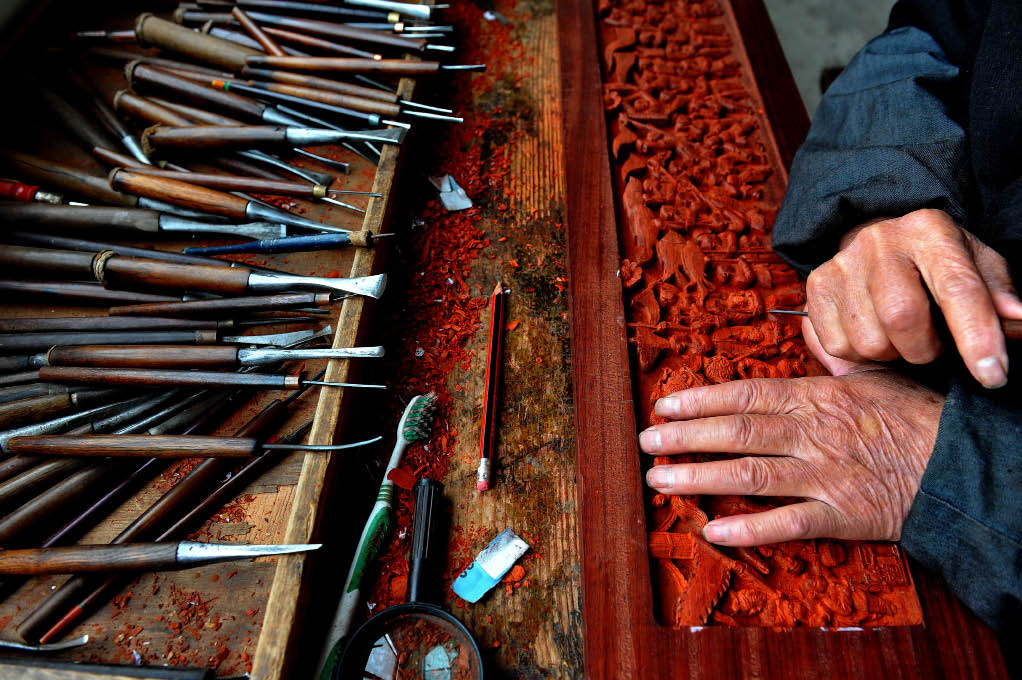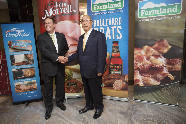Huizhou Woodcarver and Inheritor Wang Jinsheng
By staff reporter JIAO FENG
HUIZHOU, renamed Huangshan in 1987, has for centuries been a main cultural and economic hub. Anhui merchants and businesses were prominent in China’s economy from the 14th to 19th century, and fundamental to formation of Huizhounology, which along with Dunhuangnology and Tibetology is one of China’s three main regional cultures. Traditional Huizhou woodcarving is manifest in embellishments to house beams, screens, window lattices and balustrades, as well as tables, chairs, cabinets and beds. An influential school in the history of Chinese folk woodcarving it is, along with Huizhou stone and brick carving, known as one of Huizhou’s “three carvings.”
Wang Jinsheng’s vitality belies his 85 years. He ushered us into his studio, where two of his apprentices were busy on one bench, while semi-finished works stood on another. Besides teaching apprentices each day, Wang also creates his own carvings. Working at what most interests him keeps him both mentally and physically fit.
 |
| At age 85 Wang Jinsheng still puts in long hours at his woodcarving studio every day. |
Apprentice to a Woodcarving Master
Wang Jinsheng told us about his life as we sat in his austere living room.
A sickly child, Wang’s parents put him under the tutelage of celebrated Huizhou woodcarving master Wang Xulun. Their motive was to train him in a skill that would obviate heavy manual labor on reaching adulthood. “Having been raised in a home environment rich in artistic carvings, I had an innate admiration for them and so was happy with my parents’ arrangement,” Wang told us. Wang was proud of his master, who attended the first National Conference of Outstanding Workers as representative of Huizhou woodcarving, and had his photo taken with Marshall Zhu De.
During his time as an apprentice Wang and his master applied their skills to refurbishments of ancestral halls around Huizhou. Working under strict guidance of his teacher laid a solid foundation for Wang’s later achievements.
Years of hard work enabled Wang gradually and comprehensively to master the art of woodcarving. In 1951, he was transferred to Hefei, capital city of Anhui Province, where he worked at the Hefei Arts and Crafts Factory. Other than Wang Jinsheng and one other novitiate, all workers at this new factory were seasoned craftsmen. Wang nonetheless stood out by virtue of his obvious talent. He participated in all major events of the factory, notably creating woodcarvings for the first agricultural exhibition in Beijing after the founding of the PRC. Seven years later in 1958, when the Great Hall of the People was under construction in Tian’anmen Square, he was again dispatched to Beijing to do woodcarvings for the building’s Anhui Hall.
Shezhou Inkstone Revival
The four treasures of the study – inkstone, calligraphy brush, inkstick and rice paper – were essential aspects of the daily life of venerable scholars. Shezhou inkstone is regarded as the most precious. Owing to wars during the early 20th century, production of Shezhou inkstones ceased and did not resume until the founding of the PRC in 1949.
“In the early 1960s, the Anhui provincial government assigned me the task of reviving Shezhou inkstones. Despite generally hard times, the government allocated the funds I and my team needed to carry out research,” Wang Jinsheng recalled. It was during this decade that Wang was transferred back to the arts and crafts factory in Shexian County.
His first task was to locate the source of raw material for the inkstone. After studying historical records, Wang and his fellows traveled to Yanshi Mountain in Wuyuan of Jiangxi Province, where rock quarrying had stopped decades earlier. They next studied the craft of inkstone carving. With the benefit of deep knowledge and decades of practice in woodcarving, they carried out explorations and trials of its various shapes and styles. “We rubbed and carved day and night. Intent on making the finest possible inkstones, we were immersed in our work.” Wang and his team finally succeeded in both creating and innovating Shezhou inkstones.
In 1967, the 12 samples of Shezhou inkstones Wang and his colleagues had produced went on exhibition in Shanghai. Eleven of them were particularly admired by foreign businesspeople, and soon went into mass production. “That marked the first time Shezhou inkstones became known in the market, and before long they were in high demand. Years later, Chinese leaders on state visits abroad would present Shezhou inkstones as national gifts to their foreign counterparts, and people in their thousands visited the Shexian County Arts and Crafts Factory to observe the manufacturing process,” Wang Jinsheng said.

